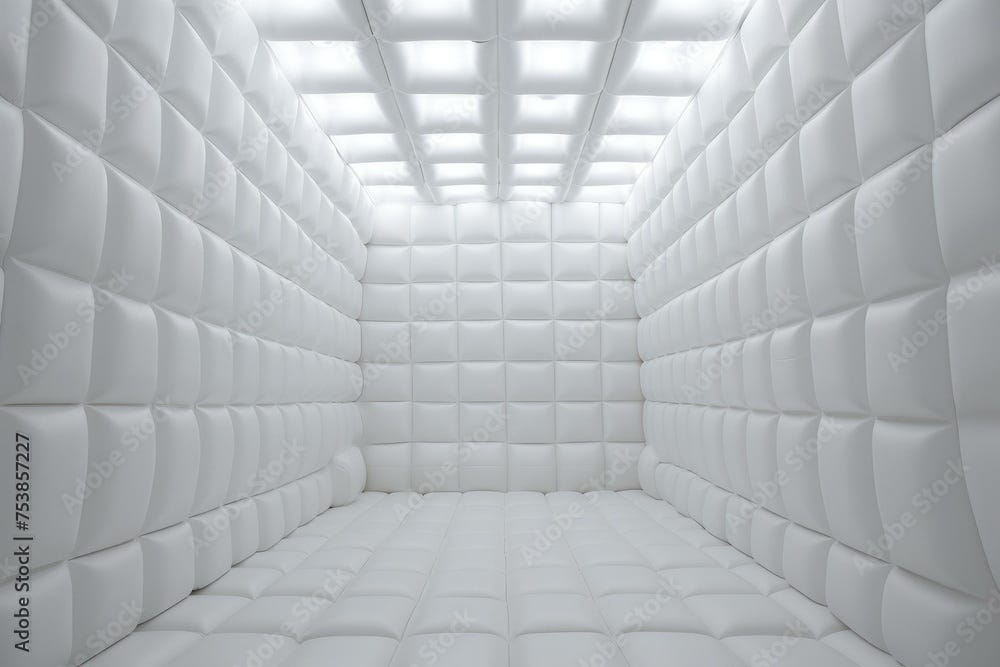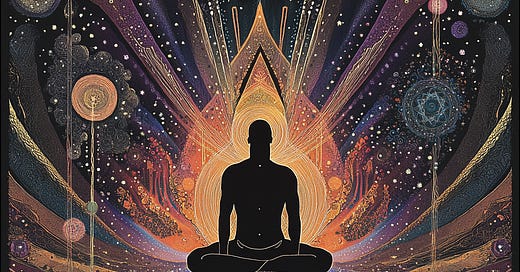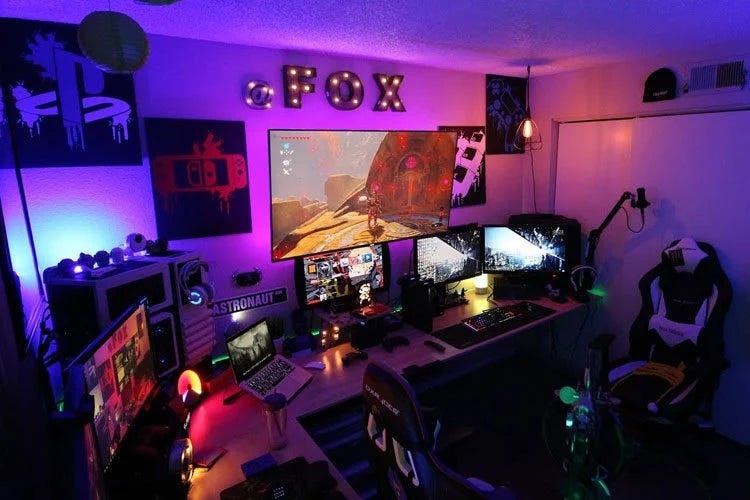Conquer ADHD- Regulating your Dopaminergic System To Maximize Outcomes (Part 2)
Step 1: Simplify
Intro
Today’s article will be about a topic that’s close to the heart.
There are 13 million sales people in the United States of America.
About 6% of the United States adult population has been diagnosed with ADHD.
Assuming a normal distribution of ADHD-prevalence in the sales industry (although we would hazard a guess that it’s higher than gen-pop), then that would mean there are 790,995 sales people who have ADHD.
If you think you’re one of them, and have been frustrated by efforts to productively harness your neurodivergence, this article is for you.
Treating Symptoms Rather Than Causes
If your experience was anything like ours, going to a specialist for ADHD treatment looked similar to the following:
Take test to determine neurotypicality
Receive diagnosis of neurodivergence
Get a prescription for chronic stimulant use with no long term plan to address root causes of neurodivergence
One hypothesis for the cause of ADHD is a dysfunction of dopamine transporters (DAT). TLDR: People who have ADHD may have a higher concentration of dopamine transporters in certain brain areas. These transporters remove dopamine from brain cells more quickly, reducing its effectiveness. Thus, the short attention spans and inability to focus that are hallmarks of the ADHD brain may be explained simply by the instinctive need to continually replenish dopamine levels that drop faster than that of the neurotypical. A logical answer may be to flood the brain with dopamine via stimulants, but such measures come with a host of side effects - irritability, high blood pressure, difficulty sleeping, appetite suppression, nausea. Additionally, tolerance is quickly built, requiring higher and higher doses of the same substance to achieve the same effects (while side-effects get exponentially worse).
“Show me the incentives and I’ll show you the outcome”, Charlie Munger (RIP) famously said, and through this lens the “take drugs forever” answer makes a lot of sense. After all, if you’re a solutions provider, it’s hard to beat prescribing a plan of action that involves 1. monthly recurring purchases 2. potentially increased monthly purchases and 3. solving for the problems caused by 1 and 2 with cross-selling OTHER purchases. Plainly, there is no incentive to prescribe a path that involves independence from the prescribers.
Since we have nothing to sell you, we’re going to go a different way.
Today, we’re going to dive deeper into the evolutionary value of dopamine, the implications for that adaptation in the modern day, and some adjustments you can make to harness your incredibly powerful, built-in neurochemical feedback loop to accomplish your goals.
A More Sustainable Answer: Environmental Design
“The problem isn’t that we pay attention to things,” behavioralist and real-life Skyrim Yeti Dr. Trevor Kashey muses, “It’s that things pay attention to us.”
Hidden beneath this apparently-cryptic statement is a fundamental truism about where our attention goes and why: We’re constantly learning what things to focus on by ranking what pays the most attention (in the form of dopamine release) back to us.
An Evolutionary Perspective
At one point in time, the dopaminergic feedback loop was tightly tied to survival: After all, absent a mechanism to motivate and increase the probability of doing the essentials like hunting, building shelter and reproduction, then you and your entire bloodline were probably toast. Consequently, if you’re reading this (AKA your ancestors did a good enough job of survival for you to be here) then you have inherited this same powerful neurochemical feedback loop.
The problem is that this same reward system that served your ancestors millennia ago has now been hijacked for special interests beyond your own: As humanity clawed it’s way up the food chain and ascended Maslow’s hierarchy of needs, two other phenomena have become true in inverse proportion: (1) The difficulty of “surviving” has decreased dramatically (2) and with the surplus time and attention previously dedicated to survival, humans have found other, more enjoyable things to do with their time.
Entrepreneur Alex Becker articulates the challenge with regulating your dopamine system in the modern era well: “The problem is that dopamine [today] has absolutely nothing to do with what is going to make your life better or worse". Using a computing analogy, he points out that “your brain thinks in 1’s and 0’s - 1 is pleasure and 0 is pain - and it’s always going to take the path of least resistance and convince you to move toward the 1.”
The interesting implication here? It’s all relative. Let’s circle back on what we said earlier about how our dopamine system thinks in terms of ranking with an analogy.
Let’s say a benevolent scientist committed to showing you the power of your neurochemistry kidnaps you and places you in an empty room with a locked door for 48 hours. You have no way of contacting the outside world, nor entertainment of any kind. At hour 48, you hear keys jingle before a slot in the door opens and a copy of War and Peace comes flying through it, landing with a hearty chunk at your feet. Chances are pretty good at this stage that even if you’re not much of a reader that you would find yourself engrossed in the novel - after all, it beats sitting in a completely empty room doing nothing.

Now let’s say that same scientist then kidnaps you and drops you into a room with flat screen televisions everywhere with unlimited channels, a huge variety of foods and drinks, video game systems etc. At hour 48, War and Peace is once again presented. What do you think the chances of reading the Tolstoyian masterpiece are here?
For better and for worse, we live in world 2.
The smart phone has created a world with limitless possibilities and the promise of never having to “suffer” boredom ever again. Like a digital binky, the slightest bit of discomfort is alleviated by the pacifying siren song of easy dopamine - and going back to the 1’s and 0’s analogy, it’s going to pick 1 every time.
Advertisers, like creepy little parasites, have figured this out and capitalized on it, hijacking the same feedback loop that once motivated your ancestors to slay mammoths and wrestle sabertooth tigers to turn you into a slackjawed, empty-headed consumer, foregoing your own hopes, dreams and aspirations in service of the people and organizations that have reduced your entire existence down to an “impression” - eyeballs on an ad widget to be quantified and converted into revenue.
Netflix CEO and apparent James Bond villain Reed Hastings says the quiet part out loud: “You know, think about it, when you watch a show on Netflix and you get addicted to it, you stay up late at night. We're competing with sleep, on the margin.”
To be fair, modern companies are simply continuing an ancient practice: Your attention has always been a commodity. Advertising has existed in for thousands of years - some of the first examples of “copywriting” are found on papyrus courtesy of the ancient Egyptians - the difference today is that getting away from propagandization has never been more difficult: The combination of our permanent reachability and the lower barriers to entry for advertising means that the war for our attention has never been fiercer.
It turns out the prophet of our time was not George Orwell, but Aldous Huxley:
"There will be, in the next generation or so, a pharmacological method of making people love their servitude, and producing dictatorship without tears, so to speak, producing a kind of painless concentration camp for entire societies, so that people will in fact have their liberties taken away from them, but will rather enjoy it, because they will be distracted from any desire to rebel by propaganda or brainwashing, or brainwashing enhanced by pharmacological methods. And this seems to be the final revolution."
So what are we to do about all this?
We will break our answer down into a couple different fields: (1) Simplifying (2) Gamification
Simplifying
Remember what we said earlier about how dopamine release is relative: Your brain is sorting for the highest dopamine release out of all available options.
The way you take advantage of this? You design your environment in such a way that the most dopaminergic option IS what moves you toward your goals.
This is, ostensibly, the whole point of having a room dedicated to working, AKA an “office”. If when you’re in your office you retain the option to do a whole bunch of non-work related things, then you’ve defeated the purpose of having an office to begin with.
Simply put, the fewer sources of dopamine you allow for yourself, the more you force your brain to derive enjoyment from whatever remains. In the absence of such artificial restriction, there will always be a temptation to take the path of least resistance.
Take a page out of the $100 Million Dollar Man Alex Hormozi’s book and build your very own “Harry Potter’s under the bed platform 9 and 3/4’s” work space.
“I get really distracted with any kind of outside people walking by..or windows, and so when I work there I can just plug in and focus on my work.”
If you’re really committed, you can go a step further and follow in the footsteps of Alex Becker, who sold all his possessions, leaving only a bed, desk and his computer in the single-minded pursuit of building his company.
Sound extreme? It is (for what it’s worth, Becker sold said-company for $110,000,000 less than 3 years after releasing this video) - but the reality is if you give yourself nothing to do but work, you’ll probably work a whole lot more and get more done as a consequence.
Focusing The Laser
Sam Ovens likens your focus to a laser beam - the more directions you try to refract that beam, the less powerful it is. Conversely, if you focus that same laser down to as small a point as possible, it will absolutely burn through whatever it’s directed toward.
Action Items
Lest you think I’m encouraging you to abandon everything for the ascetic pursuit of your entrepreneurial dreams, there’s plenty of things you can do to reduce the drag on your mental CPU and facilitate making the “right” decisions more enjoyable:
Strip your office and desk down to the barest of essentials - if you have wires everywhere, invest in wireless variations of all your ancillary equipment. Remove absolutely everything from your desk that isn’t mission critical.
Do the same for your desktop - install all unnecessary applications
Install an app to track your screen time by application and then block all apps that take time away from moving the ball forward toward your goals
Turn your smart phone into a dumb phone by installing “Blank” and then putting it in another room when you work
Take a page out of the Steve Jobs playbook and get a few variations of your favorite outfit and get rid of the rest of your closet. Better yet, rep YOUR brand vs. producing impressions for somebody else’s.
Stick to a schedule 7 days a week. Wake up and go to bed at the same time every day, do work during consistent blocks. Do nothing else. Soon, following that routine will be its own source of dopamine.
Lose the utterly pointless head scratching and pontification over “what should we eat?” that most people allow to eat up precious minutes of their day and eat the same things at the same times every day. Sound fun? Probably not - but not only is consistent food intake great for your energy levels, it’s also an easy low hanging fruit when it comes to stacking the deck to getting dopamine only from moving toward your goals. Additionally, you know what is fun? Winning and being jacked.
Stick to a regular exercise routine - lifting weights and doing cardio is good for you AND releases a ton of dopamine. By timing the things we need to do immediately before or after these boosts, We find it much easier to “do less dumb stuff and more smart stuff” (H/T Dr. Trevor Kashey) when we stick to a schedule and use exercise as our “dopamine booster”, it creates a positive feedback loop that magnifies the amount of dopamine we get from doing the things that move us toward our goals.
Conclusion
Today, we introduced a different perspective on ADHD and talked about setting our life up to harness this powerful neurochemical feedback loop by eliminating unproductive sources of dopamine, as well as provided some take actions to streamline your day and make progressing toward your goals the most enjoyable thing you can do.
Next week, we’re going to talk about gamifying the behaviors that are left in order to super-charge the amount of enjoyment you get from them, with the goal of progressing you from “I do these things because they’re all I have” to “I can’t stop doing these things because I’ve trained myself to be obsessed with them”
If any of this hits home, drop a comment below or shoot me an email (charles@needham.co). I’d love to hear from you.
Rooting for you always,
Charles
Disclaimer: This article describes my personal experiences with Attention-Deficit/Hyperactivity Disorder (ADHD) and the strategies that have helped me manage my symptoms. It is important to note that ADHD is a complex neurodevelopmental disorder that affects individuals differently. The approaches that worked for me may not be suitable or effective for everyone. This article is not intended to provide medical advice, diagnosis, or treatment. Always consult with a qualified healthcare professional or mental health expert for proper diagnosis, treatment options, and personalized care. The information presented here is for educational purposes only and should not be used as a substitute for professional medical advice.








Love the advice here. Can’t wait for the gamification. It. My biggest challenge is my son. Hard to be laser focused when you have drop off, pick up and family obligations